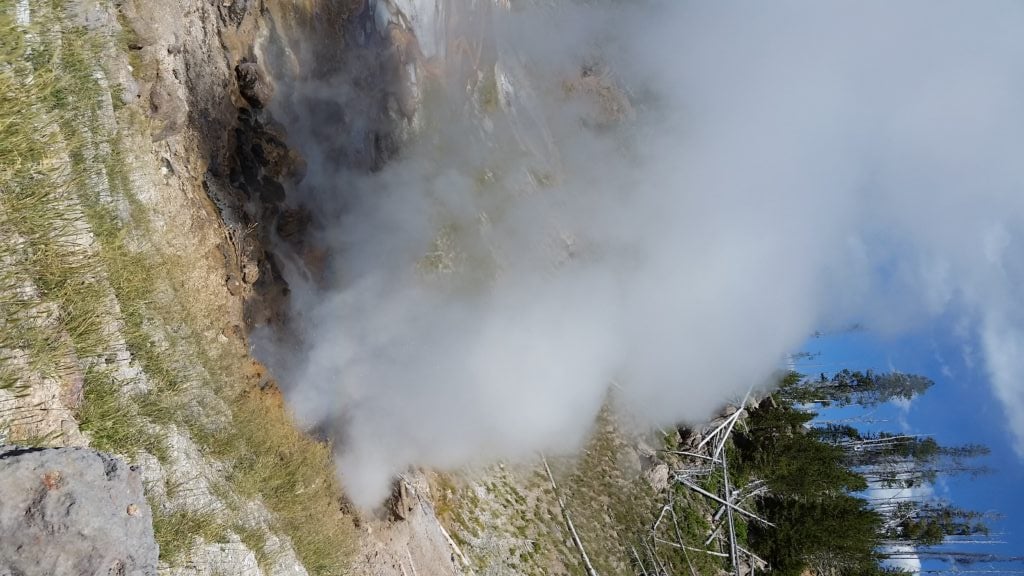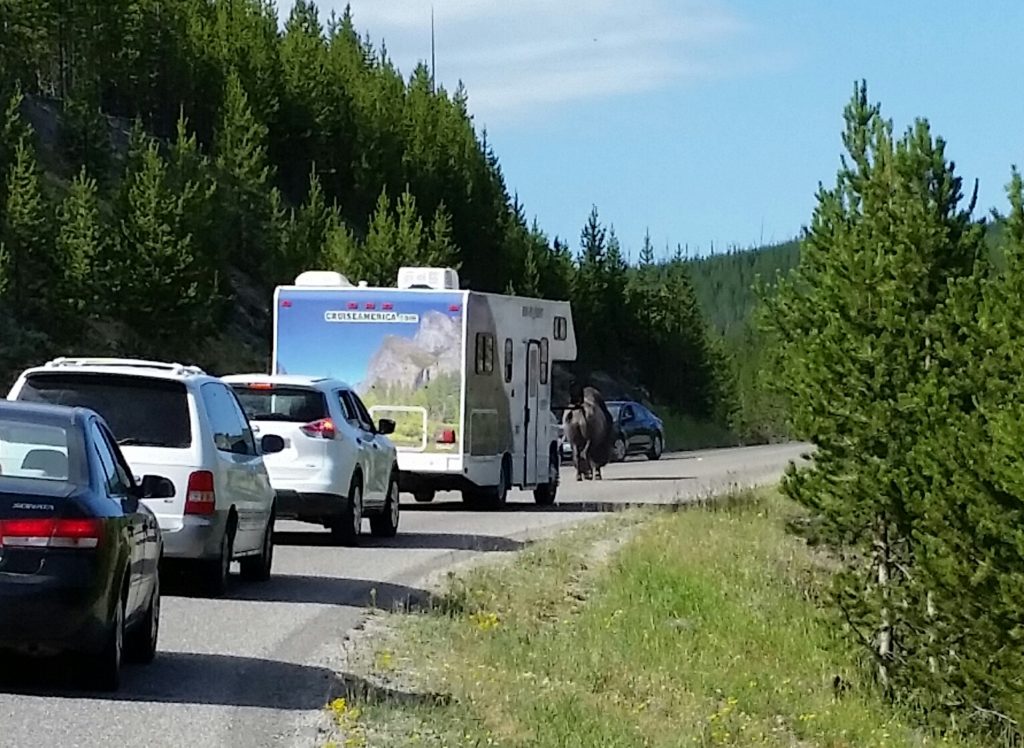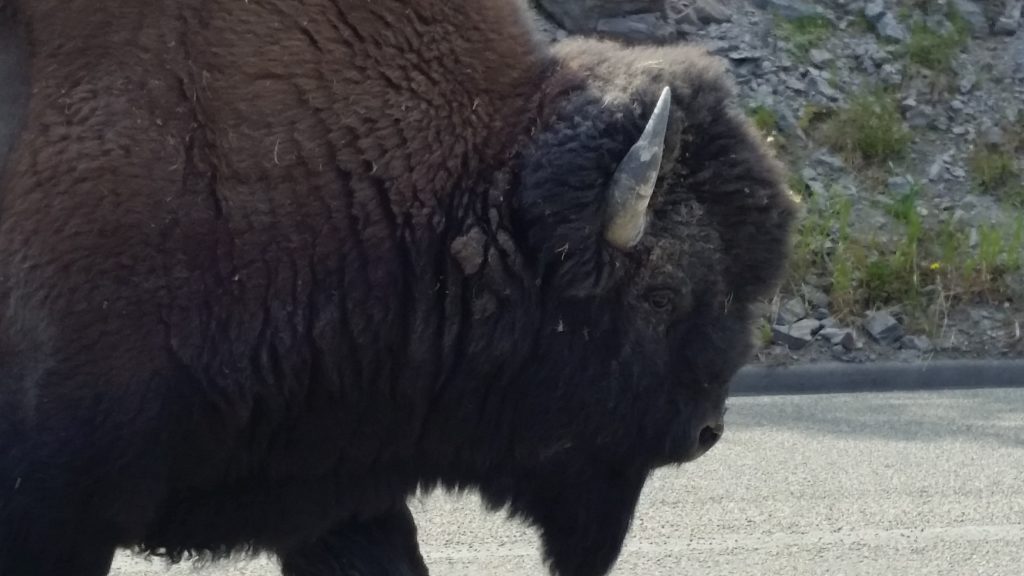We were an eleven-person ant-line marching down the boardwalk, laden with oversized, overstuffed backpacks, coolers, and tiny buckets on six-foot handles. The path to Artists’ Paintpot bore left, preparing to ascend. Steam plumed out of the Earth ahead on the right. Our leader veered left and stepped off onto spongy moss and plunged into scrubby pine forest. For the next hour, we bushwhacked our way around the mountain and up the adjacent valley. We pushed through the “green blizzard,” a limb-scratching forest of young pines. We scrambled over fields of fallen and rotting logs, as though we’d wandered into an over-sized game of pick-up-sticks. We crossed a laughing, bathtub-warm mountain stream and followed it through bogs and uphill. At last, we emerged into a primordial landscape—a barren field pocked with bubbling pools, steaming potholes, and boiling mud. One would not be surprised to see a Triceratops make its way gingerly across it. As we entered the field site, steam and water blasted out of a pile of rocks, a hundred feet into the air, as if saluting. “Hello, Avalanche Geyser,” said our leader, Dr. Everett Shock. “Nice to see you, too.”

I am trying to get a handle on the origin of life. One way to do that is to study organisms and environments in our world that approximate features of that ancient one. So I tagged along with Shock, to the back country of Yellowstone National Park. Its geothermal pools and springs are among the harshest habitable conditions on the planet. But in them life indeed thrives: diverse communities of microbes that most scientists place on the shortest, deepest branches of the tree of life. From them, Shock gleans clues to how early life may have coped with similar conditions. He goes to Yellowstone every summer with his group “GEOPIG,” the Group Exploring Organic Processes in Geochemistry.” The GEOPIGs’ motto is, “The biochemistry we have is the biochemistry Earth allows.”
Barring a time machine, anyone trying to think about the origin of life has to make assumptions. Everyone has their own model, which stresses certain variables and ignores others. In recent years, something approaching consensus has emerged that life probably arose in or around an undersea geothermal vent, about four billion years ago. Such vents still exist, at sites such as Lost City, a warm alkaline vent system in the mid-Atlantic. Some researchers study Lost City itself; others make model Lost Cities in the lab (see my previous piece about my visit to the lab of Laurie Barge and Mike Russell).
Hot springs provide another point of attack. Every summer, Shock comes to Yellowstone for two weeks to gather samples from about sixty pools in remote corners of the park. One pool is basic (high pH) while a few feet away lies one that is essentially boiling sulfuric acid. Temperatures range from the forties (centigrade) to the nineties. Conductivity, sulfur, chloride, metals, organic vs. inorganic carbon, dissolved hydrogen and oxygen, amount and quality of sediment, and other factors also vary widely. All of this data goes into a database that characterizes each pool in seventy-four-dimensional space. Analyzing the samples gathered during these two weeks keeps Shock’s team busy the other fifty.
[DO NOT try this at home, kids. Even with a back-country permit, it is foolish to go poking around these pools unless you know what you’re doing. Last month, a young man wandered off-trail and fell into a Yellowstone hot spring. There were no remains to recover.]
While not identical to the early Earth, Yellowstone hot springs share some qualities with what many scientists believe were life’s initial conditions. Besides being high in temperature—similar to the “warm” hydrothermal vents that many think were the cradle of life—they are rich in the elements of the “Fe-S-C-H-O-N” system; iron, sulfur, carbon, hydrogen, oxygen, and nitrogen.
“What we’re doing is looking at the geochemical conditions that provide materials that life can take advantage of,” Shock told me, as the beautiful but deadly pools bubbled around us. “Maybe that can help us think clearly,” he said, about how some of the first organisms coped with similar environments. Life needs a carbon source, a constant source of energy, plenty of hydrogen, and important minerals such as iron, sulfur, and phosphorus. Good evidence exists that life emerged in water close to the boiling point, without free oxygen, and that it derived its energy by reducing CO2 to methane (CH4). After it became free-living, some microbes developed the ability to capture energy from sunlight rather than geothermal heat. The emergence of photosynthesis, about two billion years ago, was a huge game-changer: the oxygen that is a waste product of photosynthesis is poisonous to anaerobes. But life that could tolerate and then exploit oxygen survived the so-called Great Oxidation Event. Our modern world was off and running.
Much of this process is recapitulated in the Yellowstone pools. “There is more [genomic] diversity in these pools than in all the life you can see around us,” Shock said with an implicit sweep of the hand across the horizon. “Bison, Grizzlies, wolves, trees, grass, us,…everything.” (Indeed, one 1998 study found that none of 31 unique 16S ribosomal RNA sequences found in one pool matched that of any known organism.) Many microbes look similar under a microscope—they are the usual balls and rods and filaments. But in the 1970s, Carl Woese and George Fox showed that what used to be called the “Monera” in fact comprised two fundamentally different forms of life. Through a painstaking analysis of the RNA in ribosomes, Woese and Fox designated a new kingdom—later upgraded to a new category: domain—they called Archaea.[1] Although both a bacterium and an archaean are prokaryotic microbes, lacking a membrane-bound nucleus, they differ in the genes that encode and the proteins that compose some of life’s most ancient, fundamental structures. Among them are the various components of the ribosome itself, as well as membrane proteins key to metabolism and other cellular molecules present in some form in all organisms.
Shock’s approach, like every other in origin-of-life research, has its critics. How can you study the origin of life in an environment that’s already full of life?, some ask. How can you understand the early, oxygen-free world in pools with substantial levels of dissolved oxygen? Life has terraformed Earth almost beyond recognition. Just before the emergence of life, the Earth would have been mostly if not entirely ocean. There was little or no free oxygen, so the first life would have made its living anaerobically.
Shock doesn’t pretend that these pools and their inhabitants are identical to those at the dawn of life—he bristles at terms such as “primitive” or “living fossil.” Darwinism does not say that humans descended from chimpanzees; it says that we share a common ancestor that lived more recently than primates’ common ancestor with birds. Similarly, the microbes in Yellowstone hot springs are living very much in the present, but their lineage branched off the tree of life down close to the root. Studying them and their environments can help us understand how these deep lineages respond to particular conditions of heat, pH, mineral concentrations, and so forth, that were important in early evolution. This information can then inform models of how life’s basic biochemistry emerged.

The work would yield dividends even if it didn’t shed light on the origin of life. Our first day in Yellowstone, Shock took us to see Octopus Spring. Located just a few miles from Old Faithful, Octopus was the first pool where microbes were discovered living above the temperature at which life was thought to be sustainable, by the great microbiologist Thomas Brock, in 1966. Soon thereafter, and nearby at Mushroom Spring, Brock discovered Thermus aquaticus. [2] In the early 1980s, the brilliant but eccentric chemist Kary Mullis, then working at Cetus, one of the early California biotech companies, used the DNA polymerase from T. aquaticus in developing one of the most potent tools in the history of biotechnology. Because it is adapted to high temperatures, the so-called taq (for “T. aquaticus”) polymerase was ideal for Mullis’s polymerase chain reaction, or PCR—one of the principal tools for amplifying a small sample of DNA up to billions of copies for analysis. Mullis received a Nobel Prize in Chemistry in 1993 for the invention.
[next: the pools at Geyser Creek]
[1] For a history of Woese’s work, see Jan Sapp’s The New Foundations of Evolution (2009).
[2] Brock, T. D., & Freeze, H. (1969). Thermus aquaticus gen. n. and sp. n., a nonsporulating extreme thermophile. J Bacteriol, 98(1), 289-297. See also Brock’s “The value of basic research: discovery of Thermus aquaticus and other extreme thermophiles” (1997).


You must be logged in to post a comment.